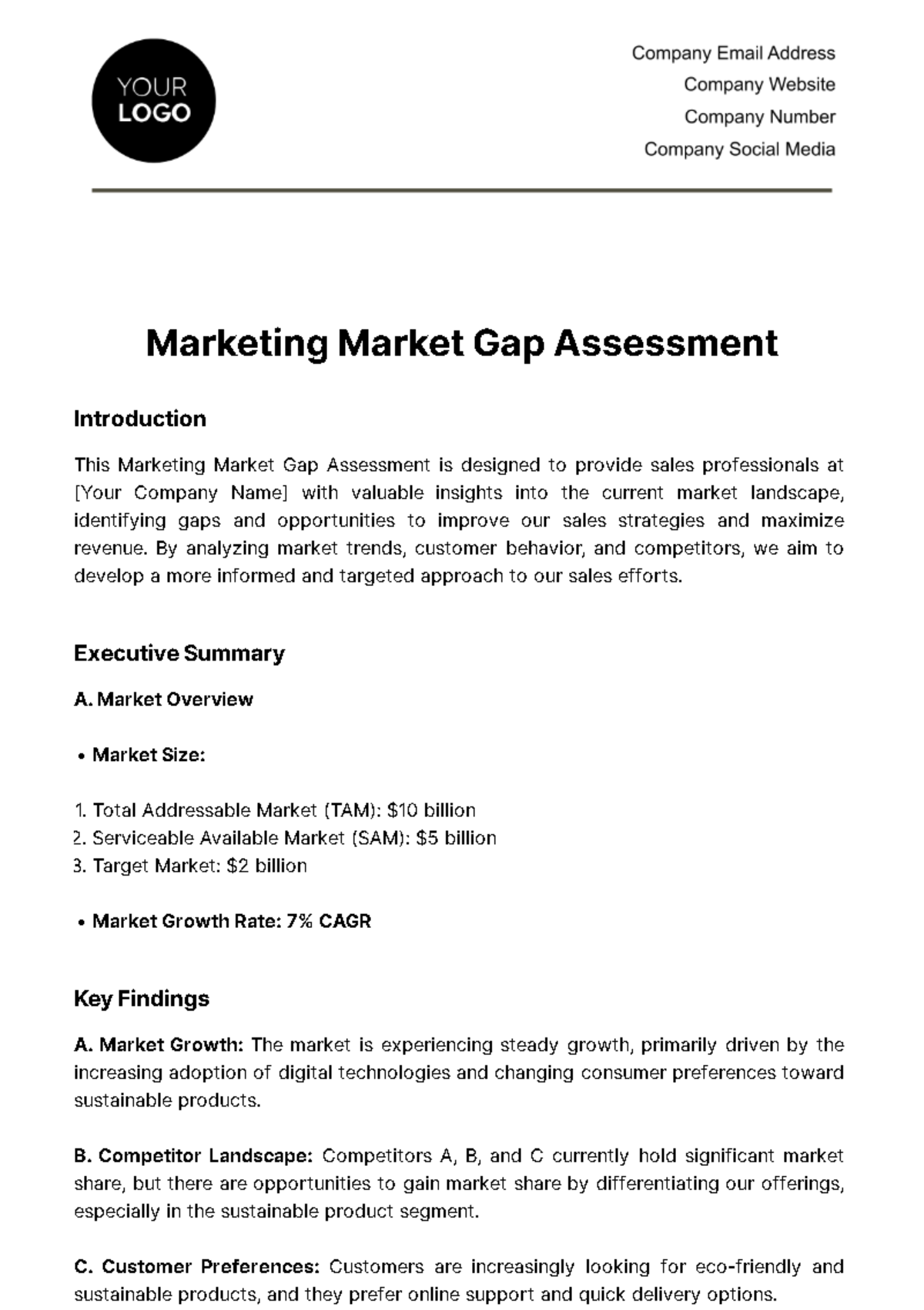Free Marketing Market Gap Assessment

Introduction
This Marketing Market Gap Assessment is designed to provide sales professionals at [Your Company Name] with valuable insights into the current market landscape, identifying gaps and opportunities to improve our sales strategies and maximize revenue. By analyzing market trends, customer behavior, and competitors, we aim to develop a more informed and targeted approach to our sales efforts.
Executive Summary
A. Market Overview
Market Size:
Total Addressable Market (TAM): $10 billion
Serviceable Available Market (SAM): $5 billion
Target Market: $2 billion
Market Growth Rate: 7% CAGR
Key Findings
A. Market Growth: The market is experiencing steady growth, primarily driven by the increasing adoption of digital technologies and changing consumer preferences toward sustainable products.
B. Competitor Landscape: Competitors A, B, and C currently hold significant market share, but there are opportunities to gain market share by differentiating our offerings, especially in the sustainable product segment.
C. Customer Preferences: Customers are increasingly looking for eco-friendly and sustainable products, and they prefer online support and quick delivery options.
D. Product Gap: Our flagship product, "SalesMax Pro," lacks some advanced features that competitors offer, such as AI-driven sales analytics and predictive lead scoring.
E. Pricing Strategy: Our pricing strategy is competitive but may need to be adjusted to capture a larger market share in the mid-tier segment.
F. Marketing Channels: Online channels, especially social media and influencer marketing, are gaining prominence. Our current social media presence needs enhancement.
Market Analysis
A. Market Trends
Increasing demand for sustainable and eco-friendly products.
Growth of e-commerce, with a shift towards online purchasing.
Rising importance of data-driven decision-making in sales.
B. Customer Segmentation
Demographics: Our target customers are primarily mid-sized businesses in North America.
Behavior: They value sales solutions that save time and improve conversion rates.
Competitor Analysis
Competitor | Market Share | Strengths | Weaknesses |
Competitor A | 25% | Strong brand recognition, AI-driven analytics | Limited customer support options, higher pricing |
Competitor B | 20% | Extensive product range, strong customer loyalty | Outdated user interface, slower product updates |
Competitor C | 18% | Competitive pricing, global reach | Limited customization options, lower customer satisfaction |
SWOT Analysis
Strengths | Weaknesses |
|
|
Opportunities | Threats |
|
|
Gap Identification
A. Product Gap
Our flagship product, "SalesMax Pro," lacks AI-driven analytics and predictive lead scoring, which competitors offer.
We need to invest in R&D to add these features and stay competitive.
B. Pricing Gap
While our pricing is competitive, it may need adjustment to capture a larger share of the mid-tier market, where competition is less intense.
C. Marketing Gap
Our social media presence is not as strong as it should be.
We need to allocate more resources to social media marketing and collaborate with influencers to expand our reach.
D. Sales and Distribution Gap
We lack a strong distribution network in the Asia-Pacific region.
Exploring partnerships and distribution channels in this region is essential for growth.
Recommendations
Product Enhancement: Invest in R&D to add AI-driven analytics and predictive lead scoring to "SalesMax Pro" to make it more competitive.
Pricing Strategy Review: Conduct a thorough pricing analysis to ensure that we are offering competitive prices, especially in the mid-tier segment.
Digital Marketing Boost: Allocate additional resources to strengthen our social media presence, engage with customers, and collaborate with influencers to reach a wider audience.
Expansion into Asia-Pacific: Identify key markets in the Asia-Pacific region and establish strategic partnerships or distribution channels to improve our presence there.
Conclusion
This Marketing Market Gap Assessment provides a comprehensive analysis of our market, highlighting key findings and recommendations to enhance our sales strategies. By addressing the identified gaps and capitalizing on opportunities, [Your Company Name] is well-positioned to strengthen its market position and achieve sustainable growth.
Marketing Templates @ Template.net
- 100% Customizable, free editor
- Access 1 Million+ Templates, photo’s & graphics
- Download or share as a template
- Click and replace photos, graphics, text, backgrounds
- Resize, crop, AI write & more
- Access advanced editor
Optimize your market strategy with Template.net's Marketing Market Gap Assessment Template. This editable and customizable tool empowers you to identify and address market gaps effectively. Utilize our Ai Editor Tool to refine your assessment with precision. Seamlessly tailor your strategy to bridge gaps and capitalize on untapped opportunities.





























